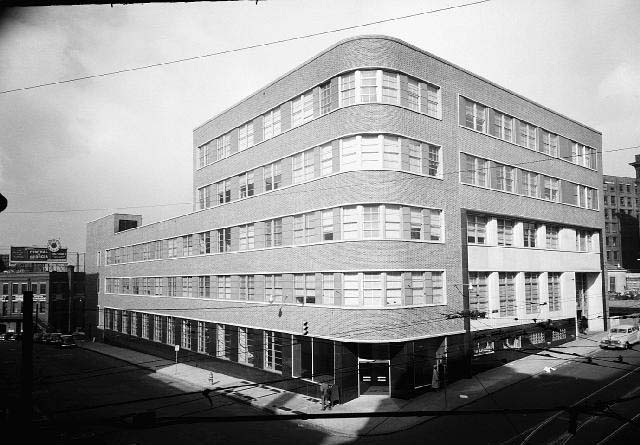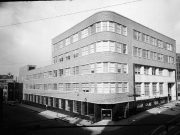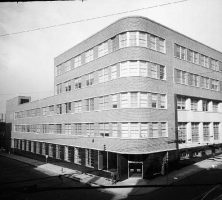In the seminal architectural exhibition organized by Philip Johnson and Henry-Russell Hitchcock in 1932 at New York’s newly opened Museum of Modern Art, Tucker and Howell was the only Georgia architectural firm to put on public view the new modern International style. The modern style was defined by European designers in landmark buildings of the late 1920s but was not evidenced in the United States, except for a few pioneer modernists, until after World War II (1941-45). Tucker and Howell was among three Georgia firms—the others were Stevens and Wilkinson, and Paul M. Heffernan—that emerged as regional leaders of the new functionalist aesthetic.

Courtesy of Special Collections & Archives, Georgia State University Library.
McKendree Tucker was born in 1896 in Bartow, Florida. He served as a pilot in World War I (1917-18) and in 1919 received a certificate in the two-year architecture course at the Georgia Institute of Technology. After graduation he and his classmate Lewis Crook (later of Ivey and Crook) began work for the Atlanta firm of Hentz, Reid, and Adler. In the late 1920s Tucker formed a partnership with Albert Howell, born in 1904, the son of Atlanta Constitution editor Clark Howell.
Tucker and Howell soon developed a specialty in theaters, designing for Georgia towns by the same name the LaGrange (1930), Manchester (1935-37), Newnan (1937), and Cedartown [West] (1941) theaters, the latter adorned with relief sculpture by Julian Hoke Harris. Other Tucker and Howell theater projects in Georgia included the Rivoli (1936) and DeSota (1939), both in Rome; the Royal (1937) in Hogansville; and the News Reel Theater (1941) in Atlanta.
During this period the firm also built several Atlanta schools, including the neoclassical Garden Hills Elementary (1938) and the Morris Brandon (1947) schools, the latter evidencing streamlined moderne and more progressive modern elements. Their most monumental work of the 1930s was the Georgia State Prison in Reidsville, a modern classic building also enriched with a Julian Harris sculpture, a frieze of emblematic figures representing trades and occupations entitled Rehabilitation. Other collaborations with the sculptor included the Morris Plan Bank (1936, razed), zoo buildings throughout the 1950s, and the Commerce Building (1959), all in Atlanta, and the DeKalb County Federal Savings and Loan Building in Conyers (1963). What might be called “family” projects include the Clark Howell residence (1938) and a 1941 project proposal for the Atlanta Constitution Building, which was ultimately built by Atlanta firm Robert and Company in 1947.
In the late 1940s and the 1950s the firm’s progressive International aesthetic moved them away from their earlier, more traditional houses and moderne and modern public buildings. This is evidenced in the Atlanta Water Bureau Construction and Maintenance Building (1947) and two Atlanta schools, Price High (1953-54, addition 1958, razed), and Emma Hutchinson Elementary (1955-56). Hutchinson was recently defaced by an ill-conceived renovation, and Price was razed despite its being one of the best early modern schools in the city.
From the 1930s through the 1950s Tucker and Howell produced noteworthy Georgia landmarks in moderne and early modern styles. It is considered one of the state’s most significant architectural firms of the period. Tucker died in 1972, and Howell died in 1974.





